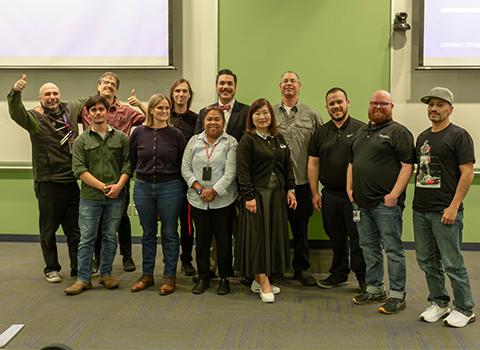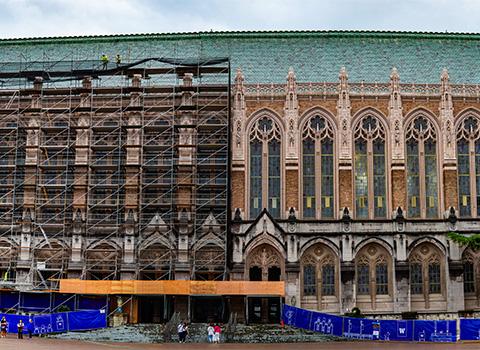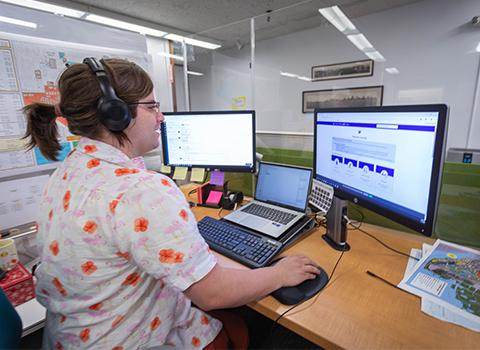Getting help from Facilities just got easier

Customer Care team member Taylor Spinney helps a customer by using ReADY, the new system for intake of customer requests. Misty Shock Rule/University of Washington
A professor needs a new keypad lock. A research scientist wants a wall in their office painted. A first-year student living in McCarty Hall notices a light flickering. A visitor to campus reports an overflowing toilet in the HUB.
These are some of the kinds of requests coming into UW Facilities (UWF) every week, which are then resolved by the hundreds of front-line staff who take care of the 150 or so buildings that make up the UW campus.
A central part of that network is the technology for getting requests from customers to those doing the work. And it just got an upgrade.
The new system, launched in April and based on a platform called ReADY, makes the process faster, more streamlined and easier to use.
In the past, when faculty, staff and students needed or wanted help, they filled out a simple form that asked only for their name, building, room and a description of the problem. This form would then be processed by UWF’s five-person Customer Care team, who would triage the query and send it to the appropriate team of leads, trade staff, custodians and more.
Sometimes that could leave room for interpretation.
“There are some people who are like, ‘Yeah, I know exactly what I'm putting here. On this door, the closer is not working.’ That’s all they needed to put,” said UWF’s Rick Trowbridge, who manages the Customer Care team. “But other people are like, ‘The door's not shutting all the way, and I don't know what it is, and where's the door, I'm not sure.’”
The Customer Care team would have to follow up on inquiries that weren’t straightforward, and if the initial requestor wasn’t available, it could take as long as a week or two.

When opening up ReADY on desktop or mobile device, customers start by choosing the type of request. Andy Krikawa/University of Washington
The new system is designed to guide customers through the process. They start by clicking on a tile to indicate the type of request, such as graffiti removal or building access.
Then, they get a series of questions related to the tile they chose, including questions drilling down on that specific issue. For example, after choosing electrical as a category, a customer can specify if they need help with replacing a light bulb, an outlet, something related to an event or another type of issue. They can then provide more information related to what they chose, like the location of the light bulb, whether there is research equipment nearby or the date of the event.
The request is then sent directly to the UWF team that will do the work, bypassing the need for Customer Care to circle back for more details or triage straightforward inquiries. That frees up Customer Care to focus on complicated issues that require extra attention.
ReADY is a modern system — it’s mobile-friendly, and the customer can upload a picture within the tool. Previously, the customer had to send a picture by email after they clicked submit.
The ability to use mobile devices and upload a picture is especially impactful for students, who are accustomed to using mobile devices in much of what they do. And it’s impactful for UWF, too. Roughly half of requests coming to UWF are made by students in student spaces, such as a plugged toilet, clogged sink or light outage.
Inspired by COVID
Inspired by COVID
As with many recent technological advances, the move toward overhauling the request intake process began with COVID, said Dennis Garberg, interim executive director of UWF’s Maintenance & Construction department. With fewer people on campus, it was harder to circle back with customers to get more information.
“We didn't have that face-to-face time,” Garberg said. “COVID prepared us to look at our system and see where we could be better or timely with work orders for sure."
That led to an effort, spearheaded by UWF’s Business Innovation & Technology (BIT) team, to examine all ways UWF takes in requests, which currently consist of multiple tools and methods. Implementing ReADY was the first step. Now, they are working on standardizing systems for requests outside of ReADY, including building renovations, capital projects and more.
With the development of ReADY, BIT undertook a slow, deliberate process to make sure all pieces were in place to ensure a successful launch, learning from past efforts that lost momentum.

In May 2024, building coordinators took part in a card-sorting exercise, hosted by the UWF's Business Innovation & Technology team, which helped guide the future design of ReADY. Ina Dash Stap/University of Washingon
A steering committee and strong executive sponsorship pushed the project forward. BIT got multiple rounds of input from customers like UW Housing & Food Services and building coordinators — the system’s “super users” — as well as the UWF staff doing the work. Those partnerships informed ReADY’s design, from the selection of the tiles and categories to the questions associated with each of them.
Collaboration, overcommunication and training ensured that key stakeholders were ready when ReADY launched in April.
These are all strategies BIT will use as it rolls out future changes.
“We're going to give everybody a chance to come along with us on that journey,” said UWF Information Technology Director Tim Rhoades. “That way, when that next big thing happens, there's more trust and more willingness to change with the next thing that we do.”
For UWF, it all comes down to serving customers.
"The big thing for me is thinking about what does it really look like to do transformational work, versus just, ‘Yeah, we manage a technology tool,’” said Amee Patel, BIT’s change manager who managed the collaboration with stakeholders during the development of ReADY. "The people are at the core. If the people aren't being served, you haven't done anything transformative.”
And by serving the customers, UWF serves the University.
“Whether it be on the facilities side or on the building side as a customer, we’re here to work together” said Jim Mazurk, who oversees the Customer Care team. “We're here to help serve you and make your lives easier to really fulfill the mission of the University."



